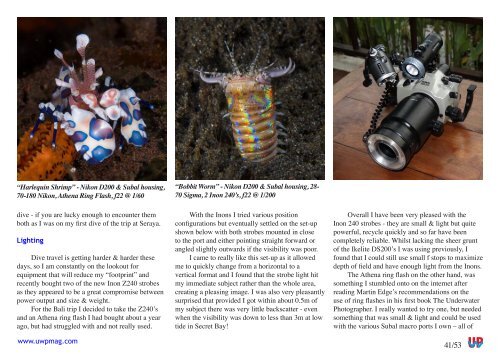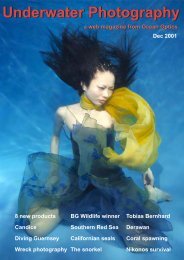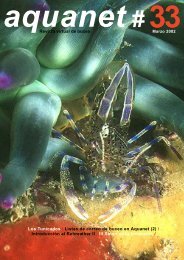Underwater Photography Underwater Photography
Underwater Photography Underwater Photography
Underwater Photography Underwater Photography
You also want an ePaper? Increase the reach of your titles
YUMPU automatically turns print PDFs into web optimized ePapers that Google loves.
“Harlequin Shrimp” - Nikon D200 & Subal housing,<br />
70-180 Nikon, Athena Ring Flash, f22 @ 1/60<br />
“Bobbit Worm” - Nikon D200 & Subal housing, 28-<br />
70 Sigma, 2 Inon 240’s, f22 @ 1/200<br />
dive - if you are lucky enough to encounter them<br />
both as I was on my first dive of the trip at Seraya.<br />
Lighting<br />
Dive travel is getting harder & harder these<br />
days, so I am constantly on the lookout for<br />
equipment that will reduce my “footprint” and<br />
recently bought two of the new Inon Z240 strobes<br />
as they appeared to be a great compromise between<br />
power output and size & weight.<br />
For the Bali trip I decided to take the Z240’s<br />
and an Athena ring flash I had bought about a year<br />
ago, but had struggled with and not really used.<br />
www.uwpmag.com<br />
With the Inons I tried various position<br />
configurations but eventually settled on the set-up<br />
shown below with both strobes mounted in close<br />
to the port and either pointing straight forward or<br />
angled slightly outwards if the visibility was poor.<br />
I came to really like this set-up as it allowed<br />
me to quickly change from a horizontal to a<br />
vertical format and I found that the strobe light hit<br />
my immediate subject rather than the whole area,<br />
creating a pleasing image. I was also very pleasantly<br />
surprised that provided I got within about 0.5m of<br />
my subject there was very little backscatter - even<br />
when the visibility was down to less than 3m at low<br />
tide in Secret Bay!<br />
Overall I have been very pleased with the<br />
Inon 240 strobes - they are small & light but quite<br />
powerful, recycle quickly and so far have been<br />
completely reliable. Whilst lacking the sheer grunt<br />
of the Ikelite DS200’s I was using previously, I<br />
found that I could still use small f stops to maximize<br />
depth of field and have enough light from the Inons.<br />
The Athena ring flash on the other hand, was<br />
something I stumbled onto on the internet after<br />
reading Martin Edge’s recommendations on the<br />
use of ring flashes in his first book The <strong>Underwater</strong><br />
Photographer. I really wanted to try one, but needed<br />
something that was small & light and could be used<br />
with the various Subal macro ports I own – all of<br />
41/53
















